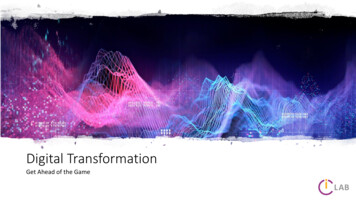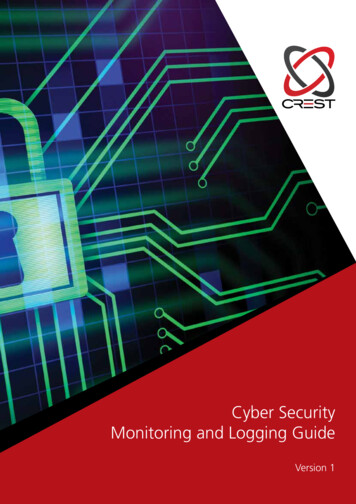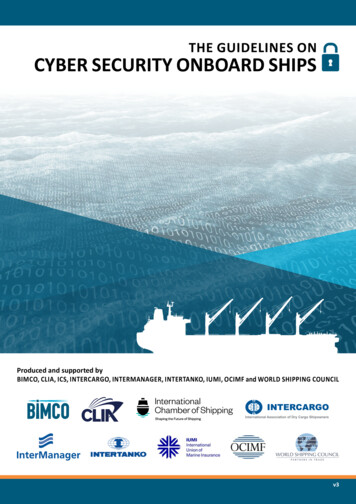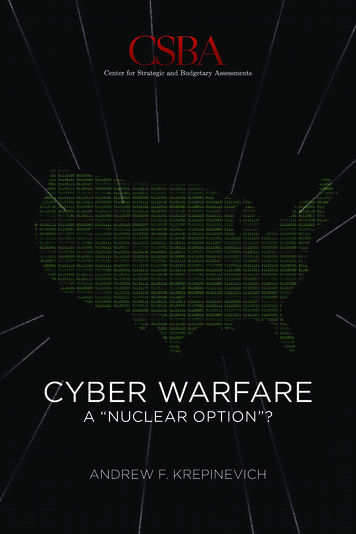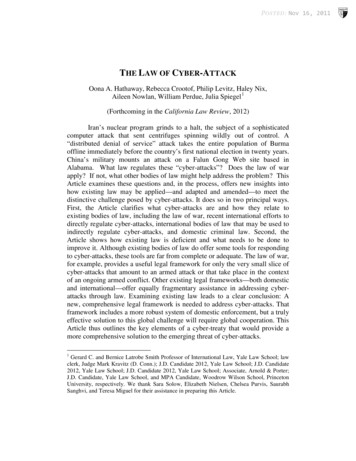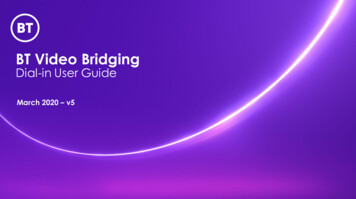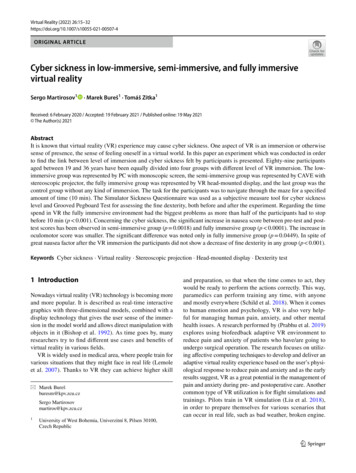
Transcription
Virtual Reality (2022) -4ORIGINAL ARTICLECyber sickness in low‑immersive, semi‑immersive, and fully immersivevirtual realitySergo Martirosov1· Marek Bureš1 · Tomáš Zítka1Received: 6 February 2020 / Accepted: 19 February 2021 / Published online: 19 May 2021 The Author(s) 2021AbstractIt is known that virtual reality (VR) experience may cause cyber sickness. One aspect of VR is an immersion or otherwisesense of presence, the sense of feeling oneself in a virtual world. In this paper an experiment which was conducted in orderto find the link between level of immersion and cyber sickness felt by participants is presented. Eighty-nine participantsaged between 19 and 36 years have been equally divided into four groups with different level of VR immersion. The lowimmersive group was represented by PC with monoscopic screen, the semi-immersive group was represented by CAVE withstereoscopic projector, the fully immersive group was represented by VR head-mounted display, and the last group was thecontrol group without any kind of immersion. The task for the participants was to navigate through the maze for a specifiedamount of time (10 min). The Simulator Sickness Questionnaire was used as a subjective measure tool for cyber sicknesslevel and Grooved Pegboard Test for assessing the fine dexterity, both before and after the experiment. Regarding the timespend in VR the fully immersive environment had the biggest problems as more than half of the participants had to stopbefore 10 min (p 0.001). Concerning the cyber sickness, the significant increase in nausea score between pre-test and posttest scores has been observed in semi-immersive group (p 0.0018) and fully immersive group (p 0.0001). The increase inoculomotor score was smaller. The significant difference was noted only in fully immersive group (p 0.0449). In spite ofgreat nausea factor after the VR immersion the participants did not show a decrease of fine dexterity in any group (p 0.001).Keywords Cyber sickness · Virtual reality · Stereoscopic projection · Head-mounted display · Dexterity test1 IntroductionNowadays virtual reality (VR) technology is becoming moreand more popular. It is described as real-time interactivegraphics with three-dimensional models, combined with adisplay technology that gives the user sense of the immersion in the model world and allows direct manipulation withobjects in it (Bishop et al. 1992). As time goes by, manyresearchers try to find different use cases and benefits ofvirtual reality in various fields.VR is widely used in medical area, where people train forvarious situations that they might face in real life (Lemoleet al. 2007). Thanks to VR they can achieve higher skill* Marek Burešburesm@kpv.zcu.czSergo Martirosovmartiros@kpv.zcu.cz1University of West Bohemia, Univerzitní 8, Pilsen 30100,Czech Republicand preparation, so that when the time comes to act, theywould be ready to perform the actions correctly. This way,paramedics can perform training any time, with anyoneand mostly everywhere (Schild et al. 2018). When it comesto human emotion and psychology, VR is also very helpful for managing human pain, anxiety, and other mentalhealth issues. A research performed by (Prabhu et al. 2019)explores using biofeedback adaptive VR environment toreduce pain and anxiety of patients who have/are going toundergo surgical operation. The research focuses on utilizing affective computing techniques to develop and deliver anadaptive virtual reality experience based on the user’s physiological response to reduce pain and anxiety and as the earlyresults suggest, VR as a great potential in the management ofpain and anxiety during pre- and postoperative care. Anothercommon type of VR utilization is for flight simulations andtrainings. Pilots train in VR simulation (Liu et al. 2018),in order to prepare themselves for various scenarios thatcan occur in real life, such as bad weather, broken engine.13Vol.:(0123456789)
16Professional pilots train mostly in special cockpits built forimmersive/realistic training.Many VR applications can be also seen in the light ofevents from the year 2020, when COVID-19 crisis broke out.VR proves to be an effective tool that can help handle thissituation by spreading awareness, improving communication between people, and help in physical rehabilitation andpain management of an infected patient during the treatment process (Singh et al. 2020). Several previous studieslike training how to properly keep hand hygiene to preventinfections (Clack et al. 2019), utilization of VR in onlineshopping with additional product visualization (Speicher2018) or opportunities and challenges in online teaching andeducation with VR support (Callaghan et al. 2015) becomevery actual in 2020.When it is impossible to perform training in real environment due to cost or complexity, VR training environments can be used to help in complex collaborative tasks(Moskaliuk et al. 2013a, b). When deciding whether to useVR or not, the DICE framework could help us. The acronym,coined by leading VR researcher and head of the StanfordVirtual Human Interaction Lab (VHIL) Jeremy Bailenson,stands for Dangerous, Impossible, Counterproductive, orExpensive and rare. In his book “Experience on Demand”(Bailenson 2018), Bailenson applies these indexes to discuss when the usage of VR is feasible or not. Moreover, VRtraining is often the only option available (Romano and Brna2001). Also, it was noted that frequent opportunities forfeedback, reflection, and revision, are important to improvethe quality of learning (National Research Council 2000)and having a prepared VR training environment makes thispossible.A serious game or applied game is a game designed primarily for professional training rather than pure entertainment (Djaouti et al. 2011). Serious games tend to be usedoften in formal education and with sufficient support areshown to be highly motivational and effective in learningcomplex tasks (Chatti et al. 2012; Eseryel et al. 2014). Serious games are very popular for training and educationalpurposes. The trend shows increasing amount of publications and popularity on this subject. A study shows thesefindings and discusses both advantages and disadvantagesof incorporating serious games into education and training(Zhonggen 2019). Virtual training environments (VTEs)keep learners motivated and engaged in learning process(Monahan et al. 2008) and have been proven very usefulin pedagogical contexts (Mikropoulos and Natsis 2011).VTEs allow wide variety of learning styles and support collaborative knowledge building and reflective thinking (Mikropoulos and Natsis 2011) as well as experiential learning(Jarmon et al. 2009). Furthermore, some VR environmentscan support multiple user collaboration/cooperation, where13Virtual Reality (2022) 26:15–32students learn together and from each other (Kitchen andMcDougall 1999).As every other technology, VR has its own drawbacks.One of the significant is the cyber sickness (CS). As CSrepresents a considerable hurdle to using VR applications,much research has been conducted in this field in order tocombat this problem. Some studies suggest systems thatwould predict the onset of CS even before occurring. Thiswould be helpful as it is often better to predict and eliminatea problem before it occurs rather than face the consequencesthat would last longer to fix. There are some guidelines (Porcino et al. 2017) to using VR in order to minimize CS levelsin head-mounted display systems. Some of those includefield of view, duration, latency (Stauffert et al. 2018), acceleration, and navigation speed (Kwok et al. 2018). Further wewill elaborate only those variables that are relevant with ourproposed experiment.Researchers believe that decreasing field of view tends todecrease VR sickness, though at the cost of sense of presence (Fernandes and Feiner 2016). As a result of increasedfield of view, users exhibited more postural instability, whichhas been suggested to be a surrogate measure for simulator sickness (Duh et al. 2001, 2002). In some research, it isnoted that 3D video yields higher discomfort levels than 2Dvideo (Kobayashi et al. 2015). It has been suggested that thesize of the monitor and the resulting display angle can alsoinfluence the severity of virtually induced motion sickness(Duh et al. 2004; Emoto et al. 2008).Often head-mounted devices are used for displaying virtual environments, and they are known to cause motion sickness (Patterson et al. 2006). A research conducted to analyzesimulator sickness score using a video game in VR withhead-mounted display (HMD), notes that sickness occurredin all participants who played the game for a maximum of50 min (Merhi et al. 2007). Similar research suggests thatsickness occurred both, in users who played a game on astandard TV screen and those with a HMD (Stoffregen et al.2008).It has been also noted that some users might exhibitsymptoms of CS, both during and after VR experience(Bowman et al. 2001). CS is different from motion sickness in the way that the user is stationary, but has a compelling sense of motion as the visual imagery changes (Lathan2001; Hale and Stanney 2002). Studies suggest that bothexposure duration and repeated exposers are significantlylinearly related to sickness outcomes (Kennedy et al. 2000).The repetitive watching of the same video image reducedsubjective score of motion sickness in 8 of the 14 participants (Sugita et al. 2007). Research showed that women aremore affected by CS than men. There is some controversywhen it comes to age factor and CS, as some authors suggestthat susceptibility to CS is greatest in younger ages; othersmention the opposite (Arns and Cerney 2005; Brooks et al.
Virtual Reality (2022) 26:15–322010). People who are suffering from fatigue, sleep loss,upset stomach, and other types of illnesses are more susceptible to CS, as well as those with a history of migraines orconcussion (Koslucher et al. 2016). It has been also notedthat psychological conditions such as anxiety can significantly increase when simulated motion increases (Bruck andWatters 2009).There is a wide variety of research conducted in the fieldof VR on simulator sickness: simulator sickness in differenttypes of moving images (Kuze and Ukai 2008), comparisonof one-screened and three-screened display types (Seay et al.2001; Jinjakam and Hamamoto 2011), relationship betweenage and sickness level (Arns and Cerney 2005; Brooks et al.2010), gender effect on simulator sickness (Parsons et al.2004; Suma et al. 2010), etc.The way how VR participants navigate and move in theVE (either by virtual or real walking) was explored in several studies. A study performed by (Suma et al. 2009) foundthat during the task requiring a navigationally complex environment and for a longer periods, it is preferable to use simulated walking. On the other hand, another study reported thatnatural walking caused less motion sickness than simulatedwalking in one out of two experiments involving a virtualmaze (Chance et al. 1998). During a similar research, nodifferences were found in simulator sickness between realwalking and several virtual travel techniques in a small virtual room (Zanbaka et al. 2005). It was also noted that morecomplex and more realistic scenarios caused higher levelsof discomfort (Davis et al. 2015).Simulation Sickness Questionnaire (SSQ) has been foundto be valid and reliable subjective measure tool for both simulator sickness and side effects experienced in VEs (Haleand Stanney 2006; Kiryu and So 2007). It is interesting tonote that the results of motion sickness after immersion inVE are much greater when both pre- and post-questionnairesare given rather than when only post-test questionnaire isused (Young et al. 2006). In several studies the SSQ wasused as a tool for evaluation CS and comparison those resultswith machine learning algorithms. The results from study(Hell and Argyriou 2019) suggest that the proposed neuralnetwork architecture provides acceptable results in predicting motion sickness. As the time goes, the database wouldbe extended more and more, which in turn would increasethe reliability and precision of machine learning results.Another study on CS prediction suggests using an objectivemetric suck as postural instability in combination with DeepLong Short-Term Memory Model that was trained to specifically evaluate this metric during the experiment (Wanget al. 2019). The effectiveness of the proposed metric wasanalyzed and compared with subjective assessment methodsbased on SSQ which showed that the proposed method hadthe potential to be deployed within a closed-loop system andget real-time performance to predict VR sickness.17There are only few studies which focus and comparethe influence of different levels of immersion on the CS. Astudy performed by (Papachristos et al. 2017) investigatedthe impact of two mainstream virtual reality headset technological approaches (oculus rift, a traditional HMD vs. amobile-based VR headset) on the levels of spatial presence,usability, workload, simulator sickness, satisfaction andlearning outcome in an educational virtual environment. Theresults, including simulation sickness, do not show differences in the variables studied, suggesting that mobile-basedVR systems could provide acceptable levels of immersiveuser experience and contribute to the pedagogical use of VR.A study presented by (Polcar and Horejsi 2015) evaluatedCS in different VE represented by PC, CAVE and OculusRift DK2. As a result the participants performing virtualtour with Oculus Rift DK2 were most affected by CS. In thestudy presented by (Kwok et al. 2018) the comparison ofCS in CAVE and HTC Vive HMD was made. Similar to theprevious study the HMD caused higher CS levels than theCAVE environment.As a lot of VR simulations are designated for health sector the effect of VR on fine dexterity is worth exploring. Forexample, a study performed by (Collins et al. 2015) testedif the augmented reality version of Nine Hole Peg dexterity test would bring same results as the physical one. Theyfound out that the current technologies are not yet reliableenough to capture real-life fine finger-level interactions fortherapeutic purposes. Another study (Waliño-Paniagua et al.2019) based on the similar principle elaborated if occupational therapy utilizing dexterity tests plus VR sessions supported by motion capture would speed up the process ofconvalescence. The Purdue Pegboard Test, the Jebsen-TaylorHand Function Test, and the Grooved Pegboard Test wereused for the physical assessment. No significant differenceswere not found in the manual dexterity between physical testperformance and the performance backed by VR simulation;however, some improvements were found regarding the precision and effectiveness of certain functional tasks.The literature review revealed that there is still a spacefor further elaboration of CS effects in different VE. Furthermore, although some studies that used dexterity testshave been found, those studies have not been using dexteritytest as a tool for CS-level evaluation. Based on the previous studies we have proposed a laboratory experiment inorder to map the level of CS in three VR environments. Thelow-immersive VR experiences are typically a desktop orlaptop screens which present the VE to a user, so that theuser does not experience the sense of actually being in theVE; the platform does not fully occlude the user’s field ofview. The semi-immersive experiences provide users with apartial VE to interact with. This type of VR is mainly usedfor educational and training purposes, and the experience ismade possible with graphical computing and large projector13
18Virtual Reality (2022) 26:15–32 Custom general questionnaire—contains information ondominant hand, and second variant focuses on submissivehand. We tested only the dominant hand. Time needed to fillall holes with pegs was measured as an indicator (Ruff andParker 1993). This dexterity test was also performed afterVR exposure for comparison.After finishing the dexterity test, the participant wasmoved to a room with specific virtual environment wherehe or she was exposed to it. There were three types of thevirtual environment according to the level of immersion. Forlow-immersive VE we used personal computer (PC) withmonoscopic screen, mouse and keyboard, semi-immersiveVE was represented by CAVE (Cave Automatic VirtualEnvironment) with Intersense IS-900 for movement and forfully immersive VE the Oculus Rift CV1 with keyboard andmouse for movement was used. There was also one controlgroup which was assigned by the task similar to the VRexperiment in the real world. Immediately after spending10 min in the virtual environment (or even less if they feltnausea) or in the real word (in case of control group), participant performed the post-test dexterity test and filled inthe second Simulation Sickness Questionnaire. Besides thequestionnaire data, the data from computers about the movement in VR, duration, etc., were obtained.The whole process took approximately 30 to 35 min. Allexperiments were done during daylight time in the earlyautumn of 2018. The weather and light conditions were alikeduring the sessions. PC and Oculus condition had slightlydimmed window blinds to minimize unwanted screen reflections. CAVE room was dimmed significantly, with only littleambient light from several computer screens. No source oflight shined directly at the participant except for the projection screen. Custom gaming questionnaire—information on 3D2.2 Design of experimental groupsDirectly after finishing the filling of the questionnaires theparticipant performed the dexterity testing. For this purposewe used standardized Groove Pegboard Test (GPT). Thetest consists of a desk with 25 holes in which the pegs arebeing inserted. The pegs have a small stump which meansthat before insertion in the working desk, they need to beturned around precisely to fit in the holes (Bryden and Roy2005). This test is thus very demanding on precise and finehandling of pegs which was the reason we selected it as theprimary idea was that VR could affect this fine dexterity.There are two variants of the test. First variant evaluates theThe virtual environment for all three scenarios was in a formof custom-made PC game built in Unity3D 5.5.2 development environment. The game scene consisted of a randomlygenerated warehouse-like maze consisting of see-throughwarehouse shelves. The maze was subsequently editedmanually to be symmetrical and to include large open areain the center of the maze. In this area, a green cross wasplaced on the floor (see Fig. 1) which was the starting pointand the point of return. In the maze a floating red ball wasrandomly spawned. The goal of the participant was to findthe red ball and pick it up by walking though it (see Fig. 2).Then a similar green ball was shown over the cross in thecenter of the maze, and participant had to return the red ballto the green one on the starting point, in order to count itto his or her score. First several red balls were placed nearthe starting area so that the participant could learn the taskeasier. The whole simulation was based on a real scenario ina warehouse where the storekeeper needs to find somethingsystems. The fully immersive VR is a digital technologythat allows users to experience artificial environments as thereal world. In other words, users perceive virtual computergenerated surrounding using visuals, auditory, and hapticsrepresented usually by head-mounted displays and gloves(Miller and Bugnariu 2016). The following research questions were formulated.Q1 What is the average time when users are experiencingsome level of cyber sickness in different virtual realityimmersions?Q2 What are cyber sickness level differences betweenlow-immersive, semi-immersive, and fully immersivevirtual reality?Q3 To what extent are the different immersions into virtual reality affecting the fine dexterity of the users?2 MethodologyThis chapter describes the used methodology. We willexplore in detail the experimental procedure, sample characteristics, and data collected.2.1 Experiment designThe experiment session consisted of pre-test questionnairesand dexterity test, maze experiment (in VE), and post-testquestionnaire and dexterity test. The pre-test questionnaireswere:age, sex, laterality an necessity of wearing glasses.graphic software utilization, intensity of playing computer games (in hours per day), preferred console, andgame controls. Standardized Simulation Sickness Questionnaire (Kennedy et al. 1993)—the questionnaire was translated toCzech by the research team. This questionnaire was filledalso post-test.13
Virtual Reality (2022) 26:15–3219keys. They could lower themselves (crouch) by pressing theControl key—this could have been used to see through theshelves. Computer setup had no problems sustaining a 60FPS frame rate. The screen used was a Dell matte FHD 24″IPS screen with 1920 1080 resolution at 60 Hz.2.4 CAVE groupFig. 1 Maze map with spawned red ball (Color figure online)in the right shelf and bring it back to a given place (like partspicking scenario). Participants of all three groups were beingexposed for 10 min to this virtual environment, but someparticipants finished earlier due to cyber sickness symptomsoccurrence.2.3 PC groupThe PC group was exposed to the virtual environment inform of a PC application. The subject was seated in a comfortable office chair in front of the computer. They used astandard office-grade keyboard and mouse. The controllingwas the same as any other first person computer game, withmouse for turning and keyboard for movement. The participants were free to use either the WSAD or the arrowThe CAVE group was exposed to the virtual reality in aCAVE-like device, consisting of a single active 3D 300′’back-projection screen with a DepthQ projector with a1280 720 resolution and an Intersense IS-900 trackingdevice (see Fig. 3). The active stereoscopy glasses wereXpand3D X101 Infinity. On top of the glasses, there wasa wired Intersense tracking sensor, allowing user to lean orcrouch realistically (again this could be used to see throughthe shelves). The position of the tracking sensor in the framewas translated to camera’s local position in the player’s rootcoordinate system. The rotation of the sensor was not transferred to the camera, so that the view could remain still andthe user could rotate the head himself. The participant wasstanding in the middle of the tracked area he could crouchphysically. For movement, he used a wired version ofIntersense Microtrax Wand flystick (controller). The wireswere tethered together and hung from the Intersense carrierframe using a karabiner, which could be moved to tweak thecables so that their weight was as least uncomfortable to theparticipant as possible. The frame rate was kept at 60 FPS.2.5 Oculus rift groupThe Oculus group’s setup was almost the same as the PCgroup’s setup. The subjects were sitting in the same chairmodel as the PC group and were controlling the environment in the same way using mouse and keyboard insteadFig. 2 Screenshot of mazescene with the red ball (Colorfigure online)13
20Virtual Reality (2022) 26:15–32Fig. 3 Setup of CAVE withparticipant performing theexperiment (Color figure online)Fig. 4 Setup of Oculus RiftCV1 with participant performing the experiment (Color figureonline)of Oculus controllers which were not available. The OculusRift CV1 headset was used for looking around in all directions (see Fig. 4). Forward movement direction after the forward key press was in the direction of the view. The headsetwas connected to a laptop able of sustaining a high 75 FPSHMD’s native frame rate. Participants used the laptop keyboard and a standard office-grade mouse.2.6 Control groupWe have also included the control group in our experiment.The main reason for including the control group was toverify the dexterity tests. The participants in control grouphad the same time (10 min) to perform the task as the participants in previous VE groups. The task was of similarkind, to go through the university corridors and search forthe red rounded markers. There were in total 15 markers13attached mostly to walls as visualized in Fig. 5. The markers were partially hidden from some viewpoints, but therewas no need to move furniture or other devices in order tosee the marker. The participants were instructed to searchfor the markers and if found, note the number of the marker.The time was measured by stopwatches which they had withthem. After 10 min the time signal informed them to returnto the starting point.2.7 ParticipantsFor the experiment, we drafted 83 students from Faculty ofMechanical Engineering, University of West Bohemia, inPilsen along with six members of research center and facultystaff which makes 89 participants (67 males, 22 females)in total. Age of participants ranged from 19 to 36 (mean22.65, median 22). Participants were randomly distributed
Virtual Reality (2022) 26:15–3221Fig. 5 Example of red marker placement in control group experiment (Color figure online)into three groups corresponding to different VR types andone control group: PC group (monoscopic screen) consisted of 21 partici-pants (15 males, 6 females). Age of participants in PCgroup ranged from 19 to 26 years, average 22.00 andmedian 22. CAVE group (stereoscopic projector) consisted of 23 participants (17 males, 6 females). Age of participants inCAVE group ranged from 20 to 31 years, average 22.95and median 23. Oculus group (VR Headset) consisted of 24 participants(20 males, 4 females). Age of participants in Oculusgroup ranged from 20 to 36 years, average 23.42 andmedian 22.5. Control group (navigation in building) consisted of 21participants (15 males, 6 females). Age of participantsranged from 20 to 29 years, average 22.10 and median21.It can be seen that age of participants did not differ significantly between groups. All participants signed theirinformed consent to take part in the experiments. The studywas approved by the university Ethics Committee. Only twoparticipants reported extended experience with immersive3D VR display, and only three participants reported watching 3D TV regularly.2.8 Statistical analysisFor the statistical evaluation the Python language (version3.7) and SciPy statistical package (version 1.1.0) were used.The obtained data were tested for normality by Pearson testin order to decide whether we should use parametric or nonparametric statistical tests. For data that were not normallydistributed we used nonparametric Kruskal–Wallis test. Thedata with normal distribution were tested by appropriateparametric analysis of variance (ANOVA) either one-wayor two-way ANOVA. We tested all hypotheses at level ofsignificance α 0.05. All effect sizes are computed according to (Coe 2002) as pre-test vs post-test measurement withpre-test measurement taking role of a control group.3 ResultsIn the following chapter we have summarized the mainresults of our experiments. We have evaluated the cybersickness level caused by different VE, behavior of participants in VR, and also the influence of VR on fine dexterity.3.1 Time spent in VRStarting with time spent in VE simulation, Fig. 6 showsthat all of the participants in PC group (on monoscopicscreen) finished simulation with no difficulties. In CAVE(stereoscopic screen), some of the participants had to stopsimulation sooner. When it comes to Oculus, we can clearlysee that only less than half of participants could make itto the end. More than half had to stop before 10-min markdue to feeling cyber sick. This difference was statisticallysignificant (p 0.00027). We have used nonparametricalKruskal–Wallis test as the data did not have normal distribution. This discrepancy poses difficulties in analysis ofother variables. Due to low number of participants we do notsplit them into groups by time and including time as factor in13
22Virtual Reality (2022) 26:15–32Fig. 7 Nausea factor boxplots (Color figure online)Fig. 6 Time spent in different VR types (Color figure online)ANOVA gives unreliable results. For this reason we presentexclusively the VR type as independent variable.3.2 Sickness scoresFor the evaluation the Simulation Sickness Questionnairewas divided into two parts. The first part was focused onnausea where we considered factors like salivation increasing, sweating, nausea, dizziness, vertigo, stomach awareness, and burping. The second part was focused on oculomotor, considering factors like fatigue, headache, eye strain,difficulty in focusing or concentrating, fullness of the head,and blurred vision.Regarding VR sickness score of nausea there were no significant differences between experimental groups in pre-testscores meaning we had homogenous sample which allowsus to compare post-test scores. Kruskal–Wallis test (data didnot have normal distribution) shows significant differencebetween post-test measurements (p 10–5). As boxplot inFig. 7 shows, this difference came from CAVE and Oculusgroups’ scores meaning that they affect nausea factor morethan other two groups. The boxplots also suggest significant difference in pre-test and post-test scores in CAVE andOculus group. This was confirmed by Wilcoxon paired tests(data did not have normal distribution) for both CAVE group(p 0.00177) and for Oculus group (p 10–4) and also theireffect sizes 0.75 and 1.8. There was no perceivable changein control group.In oculomotor score (plotted in Fig. 8), there were no significant differences between groups in pre-test scores, suggesting again that we had homogenous group. In contrastwith nausea factor, the effect is not as strongly supported byKruskal–Wallis test (p 0.00618). The differences betweengroups in post-test measurement were visibly smaller asseen in Fi
adaptive virtual reality experience based on the user's physi-ological response to reduce pain and anxiety and as the early results suggest, VR as a great potential in the management of . such as bad weather, broken engine. * Marek Bureš buresm@kpv.zcu.cz Sergo Martirosov martiros@kpv.zcu.cz 1 University of West Bohemia, Univerzitní 8 .

